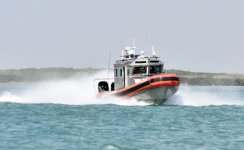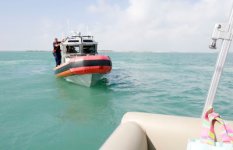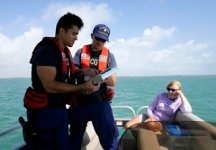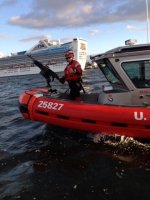Marco Flamingo
Active member
While in Friday Harbor I had the USCG inspection (which I had never had before). I only presented some of the flare/signal stuff that I have on board. Enough to pass. I knew that I was supposed to keep outdated aerial flares separate from current flares, but since I had the silly little LED light to qualify as my night signal, a lack of separation wasn't sufficient to fail the exam. I thought that it was odd that there was no question about daytime signals (smoke, flag, etc.). I don't know why this wasn't a question.
As with any exam, I found that there were some things that I could improve. One of them was a question about my "man overboard kit." My what? My "something that you can throw to a person in the water." I've got that, but in discussing it with the CG guy, I realized that it could be a really important "piece of equipment" and not just an old cushion.
Back when we kayaked whitewater, each person had a "throw bag" on deck. 50 feet of floating line in a stuff sack that had a float in it. If somebody was forced to do a "wet exit" and was floating down stream, you could toss the bag and reel them in. The person could be pulled in 20 feet downstream instead of floating 200 feet downstream. Accuracy was nice, but even a toss within 10 feet was a save.
Last week when we took Limpet out for the FH shakedown cruise, we did some MOB drills. I threw a fender in (behind Beth's back) and then said "man overboard." Not knowing exactly where it was, she did remarkably well. Made me feel better although we were in flat water with no wind. But the idea of getting the boat within 20 feet and having a throw bag and pulling the tired and/or terrified MOB to the boat definitely has some appeal.
Another item that wasn't discussed (and I just learned about this when looking for a boater class for Beth) is that both of us are now supposed to have a Washington Boater Education card. I thought that I was "aged out," but now see that every operator is supposed to have one. It is a State of Washington requirement, but if the CG doesn't ask, who does? The Sheriff at the boat ramp after there has been an accident? Plaintiff's counsel at the subsequent personal injury trial? Time for me to take another test.
Mark
As with any exam, I found that there were some things that I could improve. One of them was a question about my "man overboard kit." My what? My "something that you can throw to a person in the water." I've got that, but in discussing it with the CG guy, I realized that it could be a really important "piece of equipment" and not just an old cushion.
Back when we kayaked whitewater, each person had a "throw bag" on deck. 50 feet of floating line in a stuff sack that had a float in it. If somebody was forced to do a "wet exit" and was floating down stream, you could toss the bag and reel them in. The person could be pulled in 20 feet downstream instead of floating 200 feet downstream. Accuracy was nice, but even a toss within 10 feet was a save.
Last week when we took Limpet out for the FH shakedown cruise, we did some MOB drills. I threw a fender in (behind Beth's back) and then said "man overboard." Not knowing exactly where it was, she did remarkably well. Made me feel better although we were in flat water with no wind. But the idea of getting the boat within 20 feet and having a throw bag and pulling the tired and/or terrified MOB to the boat definitely has some appeal.
Another item that wasn't discussed (and I just learned about this when looking for a boater class for Beth) is that both of us are now supposed to have a Washington Boater Education card. I thought that I was "aged out," but now see that every operator is supposed to have one. It is a State of Washington requirement, but if the CG doesn't ask, who does? The Sheriff at the boat ramp after there has been an accident? Plaintiff's counsel at the subsequent personal injury trial? Time for me to take another test.
Mark




